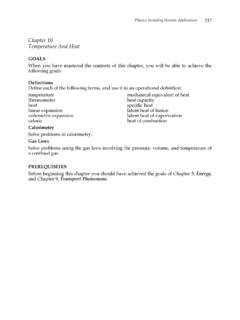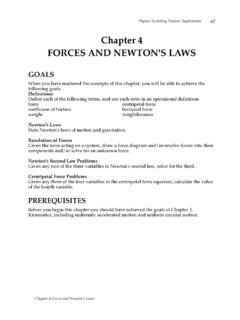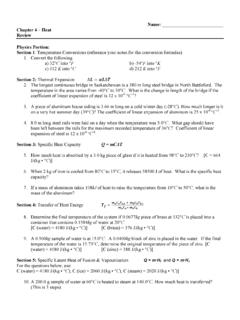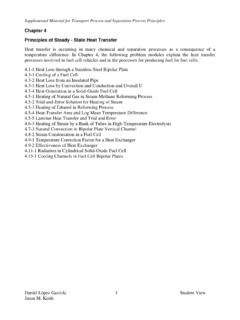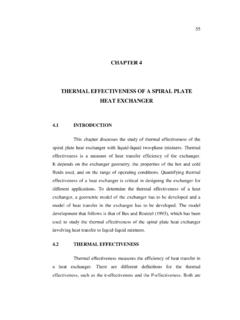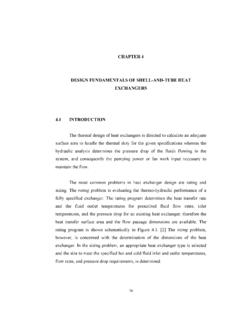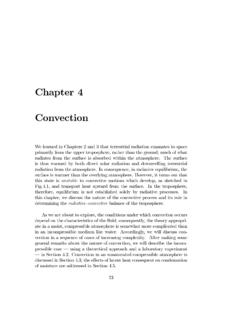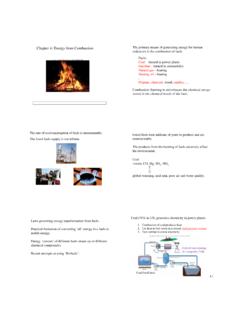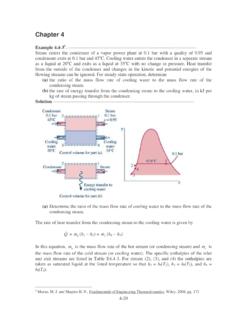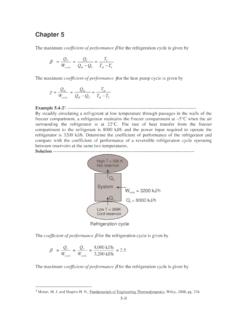Transcription of Chapter 10 Temperature and Heat - Doane College
1 Chapter 10 Temperature and heat GOALS When you have mastered the contents of this Chapter , you will be able to achieve the following goals: Definitions Define each of the following terms, and use it an operational definition: Temperature mechanical equivalent of heat thermometer heat capacity heat specific heat linear expansion latent heat of fusion volumetric expansion latent heat of vaporization calorie heat of combustion Calorimetry Solve problems in calorimetry. Gas Laws Solve problems using the gas laws involving the pressure, volume, and Temperature of a confined gas. PREREQUISITES Before beginning this Chapter you should have achieved the goals of Chapter 5, Energy, and Chapter 9, Transport Phenomena. Chapter 10 Temperature and heat OVERVIEW heat is a form of energy. As this energy moves from one object to another, we may detect physical changes in both the object losing heat energy and the object gaining heat energy.
2 This Chapter deals with many of these basic changes and the rules used to describe them. SUGGESTED STUDY PROCEDURE This Chapter places emphasis on three primary Chapter Goals: Definitions, Calorimetry, and Gas Laws. Please read these Chapter goals carefully. For an expanded discussion of the terms listed under Definitions, please turn to the next page of this Study Guide Chapter . Next, read text sections Be sure to check the answer to each question in the text readings. You will find these answers in the second section of this Chapter . Now read the Chapter Summary and complete Summary Exercises 1-12. Then do Algorithmic Problems 1-9 and check your answers carefully against the answers given in the text. Now do Problems and Exercises 1, 2, 4, 9, 10, 14, and 18. For additional examples of problems from this text Chapter , please see the Examples section of this Chapter .
3 Now you should be prepared to attempt the Practice Test over Temperature and heat . Check your answers with those given. If you have difficulties with any of the problems, refer to the appropriate text section and the suggested study procedure. This study procedure is outlined below. ---------------------------------------- ---------------------------------------- ------------------------------------- Chapter Goals Suggested Summary Algorithmic Exercises Text Readings Exercises Problems & Problems ---------------------------------------- ---------------------------------------- ------------------------------------- Definitions , , , 1-10 1, 2, 3, 4, 1, 2, 4 , , , 5, 6, 7, 8 Calorimetry 11 9, 10 Gas Laws 12 9 14, 18 DEFINITIONS Temperature The relative hotness or coldness of an object. The human body contains many Temperature sensors to inform you of the Temperature of your body and its environment.
4 THERMOMETER A device or transducer which can be used to measure the Temperature of a system. The most common kinds of thermometer are mercury in glass and red-colored alcohol in glass. heat Thermal work, a process by which the internal energy of a system is changed. LINEAR EXPANSION Change in length accompanied by a change in Temperature . Most materials increase in length when their temperatures are increased. VOLUMETRIC EXPANSION The change in volume accompanied by a change in Temperature . Most substances expand when they are heated. Water at 4 C expands if it is heated and if it is cooled! CALORIE The mean amount of heat required to increase the Temperature of one gram of water one degree Celsius. MECHANICAL EQUIVALENT OF heat The amount of mechanical energy which is equivalent to one unit of heat or thermal work. In the SI units joules is equivalent to 1 calorie.
5 Your (Fuller)3 textbook weighs about 13 Newtons. If you lift it about 32 cm you will have done about joules of work. That amount of work would raise the Temperature of 1 cubic centimeter of water one degree Celsius. heat CAPACITY Product of the mass of a body in grams and specific heat ; , amount of heat required to raise the Temperature of the body one degree Celsius. SPECIFIC heat heat energy required to raise the Temperature of a mass of material one Celsius degree. Compared to many other substances, See Table , water has a large specific heat . Water is a good substance to use for the storage of thermal energy. LATENT heat OF FUSION heat required to change unit mass of material from the solid state to the liquid at the melting point. Consider how high you would have to lift your copy of (Fuller)3 to do the amount of work equivalent to the latent heat of fusion of one cubic centimeter of ice at 0 C.
6 More than 25 meters! LATENT heat OF VAPORIZATION heat required to convert unit mass of material from liquid state to vapor state at the boiling point Temperature . Guess how high you would have to lift your copy of (Fuller)3 to do an amount of work equivalent to the amount of energy required to convert one cubic centimeter of hot water at 100 C to steam at 100 C. About 173 meters! That's much higher than the state capitol building in Lincoln, Nebraska (which is about 130 meters tall)! heat OF COMBUSTION Energy produced per unit measure of quantity of material for complete oxidation. Which would you rather oxidize, spinach or beef steak? You will get about 20 times more energy from the steak as from an equal mass of spinach. ANSWERS TO QUESTIONS FOUND IN THE TEXT SECTION Temperature Absolute zero in Celsius is C. In Fahrenheit, absolute zero is F.
7 SECTION Volumetric Expansion Let us consider a cube of side L0, then its volume is V0 at a Temperature T0. Now let us heat the cube to a new Temperature T degrees hotter than T0. Now we calculate the new volume V in terms of the volumetric coefficient of expansion , V = V0 + V = V0 + V0 T = V0(1 + T) (1) But we can use the linear measurement to calculate this same volume. V = L3 = (L0 + L0 T)3 = L03 (1 + T)3 = V0 (1 + T)3 = V0 (1 + 3 T + 3 2 T2 + 3 T3) If is much smaller than 1; then 2 << ; so neglect the 2 and 3 terms: V V0 (1 + 3 T) (2) By comparing equations (1) and (2) we see 3 SECTION heat of Combustion At this date the cost of butter is about $.80 per pound and gasoline costs about $.65 per gallon. Energy from butter = 716 kcal/100gm x 454 gm/1 lb. x 1 $.80 = 4060 kcal per dollar Energy from gasoline = 1150 kcal/100 gm x 4546 cm3/gallon x 1 gallon/$ x gm/1 cm3 = 54700 kcal per dollar Butter costs 13 times as much as gasoline per unit of energy.
8 EXAMPLES CALORIMETRY 1. A nurse withdraws 50 cc's of blood from the arm of a patient. He wants to keep the sample for a while, so he puts it in a refrigerator and cools the sample to 2 C. How much heat in calories must be removed from the blood to do this? Assume for this problem that 50 cc's of blood has a mass of 52 gm; assume that the specific heat of blood is the same as the specific heat of water; assume that the body Temperature of the patient is F or 37 C. Be sure to give the correct units. What Data Are Given? Mass of blood = 52 gm; initial Temperature of blood = 37 C; final Temperature of blood = 2 C, specific heat of blood = 103 calories per kg. What Data Are Implied? None, it is all given. What Physics Principles Are Involved? The basic Calorimetry equation ( ) is all that is needed. What Equations Are to be Used? Q = mc T ( ) Algebraic Solution heat Removed = Q = mc T Numerical Solution Q = (52 gm)(1 cal/gm)(2 C - 37 ) = x 103 calories Thinking About the Answer The change in heat , Q, is negative because heat is lost from the system of blood.
9 2. heat is required to change ice (solid) to water (liquid) without changing its Temperature . In fact, it requires 80 calories of heat to change 1 gram of ice at 0 C to 1 gm of water at 0 C. Furthermore, heat is required to change water (liquid) to steam (gas) without changing its Temperature . In fact, under standard conditions it requires 540 calories of heat to change 1 gm. of water at 100 C to 1 gm. of steam at 100 C. (a) How much total heat is required to warm and convert a 1 gm piece of ice at 0 C to steam at 100 C under standard conditions? (b) What percentage of the total heat is used to change the 100 C water to 100 C steam? What Data Are Given? 1 gram of ice exists at 0 C. What Data Are Implied? During the heating process, no heat will be lost from the ice - water - steam system to its surroundings. What Physics Principles Are Involved?
10 The basic concepts of Calorimetry (Equation ) and changes in state (Section ) are needed. What Equations Are to be Used? Heating the water = Q = mc T ( ) Melting the ice = Qf = Lfm (3) Vaporizing the water = Qv = Lvm (4) Algebraic Solution (a) total heat = Qf + Q + Qv = mLf + mL T + mLv (5) (b) percentage for vaporization = mLv/total heat (6) Numerical Solutions (a) Qtotal = (1)(80) + (1)(1)(100 - 0) + (1)(540) = 720 calories (b) Percentage = 540/720 = 75% Thinking About the Answer Notice how much energy is required to convert the liquid water to the gaseous water, 75% of all the energy! 3. About how many hamburgers would a 91 kg (200 lb) man have to eat to enable him to climb to the top of the Nebraska capitol building, about 131 meters high? An average hamburger has a fuel value of about 250 kilocalories.
